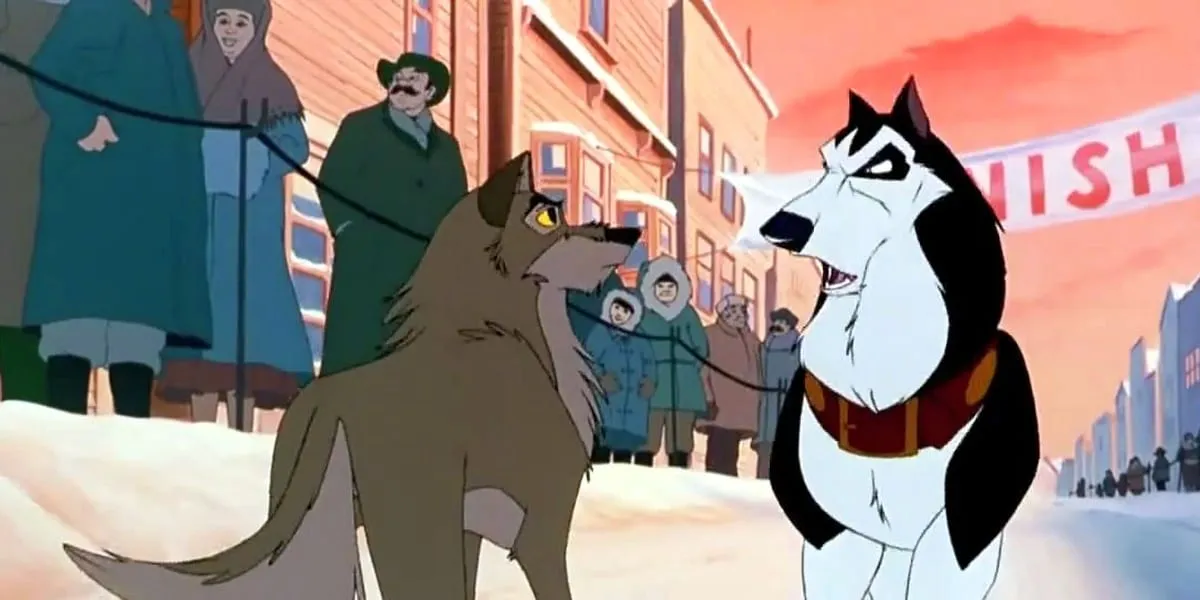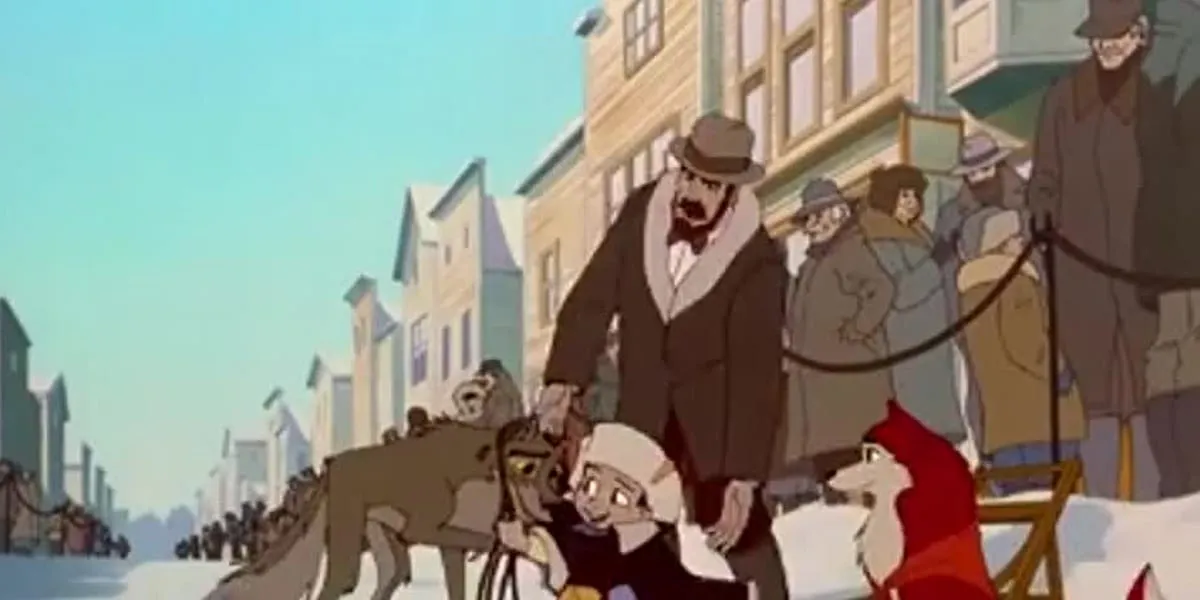The animated film Balto holds a special place in the hearts of many, myself included, as a cherished childhood movie. What makes it particularly captivating is its reliance on storytelling rather than musical numbers, allowing the narrative of struggle and triumph to unfold organically. Balto, a half-wolf, half-dog, faces immense adversity in Nome, Alaska, striving to earn the trust, affection, and respect that other dogs in his community already possess. His journey is a powerful testament to courage, willpower, and self-acceptance, resonating deeply with timeless life lessons.
The enduring appeal of Balto‘s narrative lies in its profound life lessons and its fascinating connection to history. It’s a story that encapsulates the essence of life’s challenges and the miracles that can arise from perseverance. This compelling blend makes it an essential film that continues to impart valuable wisdom. Furthermore, the movie is famously based, albeit loosely, on a true story, enhancing its impact. Exploring the connection between the animated film and the actual events reveals a captivating tale of heroism. If you’re wondering about the historical accuracy and what makes Balto a Balto Real Life Movie, you’ll discover how the animated adventure draws inspiration from the harrowing 1925 Serum Run to Nome, where an antitoxin was transported across treacherous, frozen landscapes to save children dying from diphtheria. Understanding balto movie true story adds another layer of appreciation for this beloved classic.
The Enduring Legacy of the Balto Movie
Balto‘s narrative extends far beyond a simple animated feature; it’s a saga of an underdog proving his worth against overwhelming odds. The film’s strength lies in its ability to present complex themes of identity, prejudice, and heroism in an accessible way for all ages. It champions the idea that true character shines through actions, not lineage. The movie’s careful balance of dramatic tension and heartwarming moments ensures its place as a classic that continues to inspire viewers generations after its release. It reminds us that often, the greatest heroes are those who are initially overlooked or misunderstood.
Life Lessons from Balto’s Journey
The journey of Balto is rich with teachable moments that echo universal human experiences.
Overcoming Adversity and Acceptance
Everyone encounters adversity, and Balto’s struggles are a stark depiction of this truth. As a half-wolf, half-dog, he endures constant abuse and alienation from his fellow animals in Nome. He is punished merely for his inherent nature, fitting neither entirely with dogs nor wolves. Humans, too, regard him with suspicion, refusing to trust him. Despite this persistent ostracization, Balto’s fundamental instinct is to help. He tries to ignore the taunts, even when they clearly wound him, demonstrating remarkable resilience. Balto consistently strives to be his best self, even in the face of relentless prejudice.
The Strength of an Unconventional Family
Balto is a loner, but he isn’t entirely alone. He finds solace and acceptance in his unique blended family: his adoptive father, Boris the goose, and two polar bears, Muk and Luk, who ironically cannot swim. Each member is a misfit in their own right, yet they form a cohesive unit built on mutual understanding and care. This depiction powerfully illustrates that belonging isn’t confined to traditional structures; even if you are different, there is a place and a family for you in the world. Balto’s makeshift family understands him, supports him unconditionally, and genuinely cares for him, and vice versa.
 Balto and Steele looking at one another while at a race
Balto and Steele looking at one another while at a race
Actions Speak Louder: Proving Doubters Wrong
Balto has no control over the preconceived notions of humans or other dogs about his mixed heritage. However, he has absolute control over his actions. When the critical medicine team goes missing in a blizzard, Balto’s decision to brave the severe winter conditions and rescue them is a profound act of selfless courage. It proves his deep care for the children of Nome, particularly Rosy, his friend and the only human who consistently showed him kindness. Balto’s sole objective is to save lives, a mission he undertakes at great personal risk. Even when the villainous Steele attempts to derail his efforts, Balto’s unwavering determination allows him to find his way, guiding the sled dogs back to Nome with the antitoxin just in time. His actions transcend mere heroism; they are a clear message to those who doubted him, highlighting that true character is revealed through deeds, not origins. This incredible story is a prime example of a sled dog movie true story where courage triumphs.
Embracing Your True Self
Initially, Balto feels shame regarding his wolf heritage. This is understandable, given the isolation and judgment he has experienced throughout his life because of his background. He has internalized these negative perceptions, leading to a deep dislike of this part of himself. However, in his darkest moment, when he falls down a cliff with the precious medicine in tow, he has a pivotal realization. He understands that his wolf nature, far from being a curse, is a unique gift—a distinct advantage that no other dog possesses. It provides him with the instinct and strength necessary to overcome his greatest obstacle, finding the path back and delivering the medicine. This transformative moment is about acceptance, turning a perceived weakness into a source of immense power.
 Balto pulling medicine up side of the cliff
Balto pulling medicine up side of the cliff
The Power of Self-Belief
Without a fundamental belief in his own capabilities, Balto would never have embarked on the perilous journey to find the lost sled dogs, much less guided them home. His unwavering self-confidence and refusal to give up are central to his success. He fully understands the immense risks involved and the dire consequences of failure, yet the fear of not succeeding does not deter him from pursuing his vital goals. Had Balto not acted, driven by his conviction, the children suffering from diphtheria in Nome might not have survived to tell their tales. His belief in himself, against all odds, proved to be the spark that ignited a miracle.
Beyond the Lessons: Noteworthy Cinematic Elements
While the life lessons are profound, the film offers several other remarkable elements that contribute to its lasting appeal.
A Frame Story: Rosy as the Narrator
One of the most charming aspects of Balto is the narrative choice to have an elderly Rosy as the storyteller. The film expertly blends live-action and animation, creating a seamless transition that enhances the emotional depth without being jarring. This unique approach allows the story to bridge the gap between historical events and animated heroism beautifully. Rosy’s narration provides a warm, nostalgic lens through which the tale unfolds, as she shares Balto’s story with her granddaughter during a walk through Central Park, culminating at the statue dedicated to none other than Balto himself. This narrative device ensures that the story feels timeless and deeply personal, making it resonate effectively even today.
The Importance of a Support System
Balto, despite his reputation as a loner, is not entirely isolated. Beyond his unconventional family of Boris, Muk, and Luk, he benefits immensely from the unwavering trust of Rosy and her dog, Jenna, on whom Balto harbors a significant crush. Rosy and Jenna stand apart from the skeptical residents of Nome, believing in Balto’s inherent goodness long before he achieves hero status by delivering the medicine. Balto’s motivation isn’t to be a hero but purely to save lives. Rosy and Jenna’s steadfast faith and trust undoubtedly fuel his willpower and devotion to the children’s rescue. Knowing that others believe in him makes a crucial difference; while Balto believes in himself, having a supportive network strengthens his resolve in moments of doubt. For more stories of incredible canine loyalty, you might enjoy reading about hachi dog movie true story.
 Rosy with Balto, Jenna in the background, and her dad behind her
Rosy with Balto, Jenna in the background, and her dad behind her
Climax of Self-Acceptance
The scene where Balto feels utterly defeated, trapped at the bottom of a cliff, is arguably one of the most powerful moments in animated film. As he howls alongside a wild wolf, he finally accepts his true heritage. This profound act of self-acceptance provides him with the inner strength to overcome his formidable obstacle: retrieving the medicine and scaling the cliff back to the top. It’s a moment imbued with hope and inspiration, underscoring that embracing one’s complete identity—including aspects previously considered a burden—can unlock unparalleled resilience and power. The film would be incomplete without this pivotal scene of growth and triumph.
Justice for the Arrogant: Steele’s Downfall
The film ensures that villain Steele ultimately receives his comeuppance. His lies, arrogance, and malicious attempts to thwart the other dogs not only endanger the entire team, including the injured human musher, but also put the lives of the children in Nome at grave risk. Steele’s actions are driven solely by self-interest and a desire for glory. By the movie’s end, the entire town of Nome recognizes his true, despicable character, despising him for his deceit. This clear moral resolution reinforces the film’s themes of integrity and altruism over selfish ambition.
Balto Real Life Movie: Fact vs. Fiction
While the animated Balto movie delivers a compelling story of heroism and self-discovery, it is important to distinguish between the cinematic narrative and the actual historical events. The film is indeed a balto real life movie in that it draws inspiration from a monumental true story, but it takes significant creative liberties for dramatic effect.
The true story revolves around the 1925 Serum Run to Nome, also known as the “Great Race of Mercy.” A severe diphtheria outbreak threatened the isolated town of Nome, Alaska, and the only hope was a supply of antitoxin located in Anchorage. With air travel impossible due to extreme winter conditions, a relay of 20 mushers and approximately 150 sled dogs embarked on a treacherous 674-mile journey across Alaska’s frozen wilderness. This heroic effort took five and a half days, battling blizzards, sub-zero temperatures, and perilous icy terrain.
In this historic relay, the real Balto was indeed a hero, serving as the lead dog for the final leg of the journey, driven by musher Gunnar Kaasen. Balto successfully navigated through a blinding blizzard to deliver the antitoxin to Nome, becoming a national hero and earning a statue in New York’s Central Park. However, the movie significantly enhances Balto’s role. In the film, Balto is depicted as a lone wolfdog who finds the lost team, fights a bear, and guides the entire journey. In reality, Balto was part of the last of many teams, and the antitoxin was transferred through numerous relays.
Perhaps the most significant creative departure is the diminished role of another extraordinary sled dog, Togo. Togo, a Siberian Husky, led his musher Leonhard Seppala’s team on the longest and most dangerous leg of the relay, covering approximately 260 miles through treacherous Norton Sound. Many historians and mushers consider Togo the true unsung hero of the Serum Run due to the immense distance and severity of his team’s leg. While Balto received the fame, Togo performed arguably the most critical and arduous part of the relay. The movie’s focus on Balto is likely due to his highly publicized arrival in Nome and the subsequent statue, which made him the public face of the heroic effort. Despite these differences, the core spirit of the event—the incredible bravery of dogs and mushers working together to save a community—remains intact in the animated feature. This true story highlights why we are often drawn to a dog movie based on a true story. Learning about the real balto dog allows us to appreciate both the movie and the history even more.
Conclusion
Balto stands as an underrated animated classic, a film that masterfully blends an engaging storyline with profound life lessons. It delves into themes of adversity, identity, courage, and the power of self-belief, all while paying homage to a pivotal moment in history. The movie’s ability to tackle prejudice and champion the underdog, coupled with its unique storytelling elements like the blending of animation and live-action, cements its place as a truly inspiring film. While the animated narrative takes artistic liberties with the balto real life movie event, it successfully captures the essence of heroism, the spirit of service, and the enduring bond between humans and dogs. Balto’s journey, both fictional and historical, continues to be a powerful reminder that even the most unexpected individuals can rise to extraordinary challenges and become heroes. Explore more inspiring dog stories and movie analyses on Dog Care Story to uncover more tales of canine courage and impact.
References
- D’Amico, M. (2020, November 23). Balto: The Enduring Legacy of a Fictional Underdog. Film Obsessive.
- Wikipedia. (n.d.). Balto. Retrieved from https://en.wikipedia.org/wiki/Balto
- Wikipedia. (n.d.). 1925 serum run to Nome. Retrieved from https://en.wikipedia.org/wiki/1925_serum_run_to_Nome
- NPS.gov. (n.d.). Togo: A True Alaskan Story. Retrieved from https://www.nps.gov/bela/learn/historyculture/togo-a-true-alaskan-story.htm
